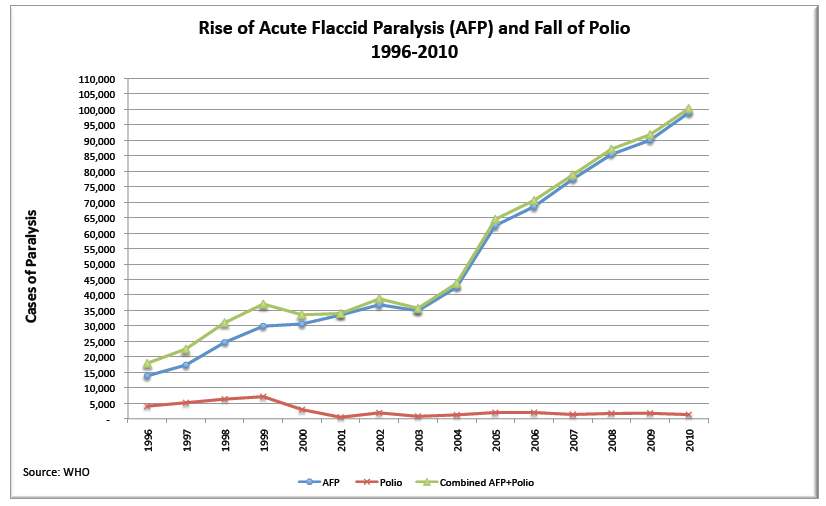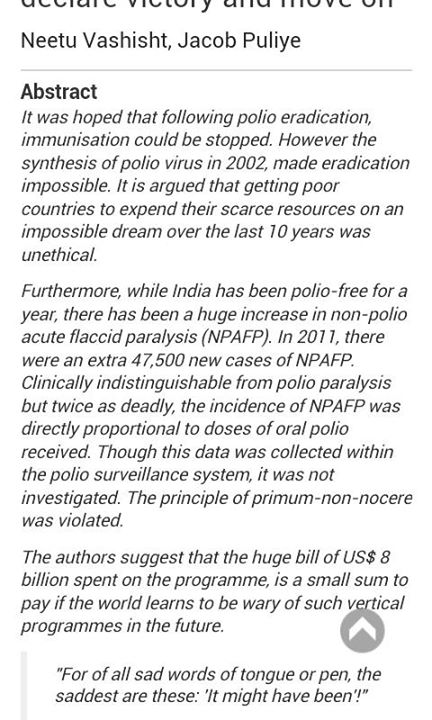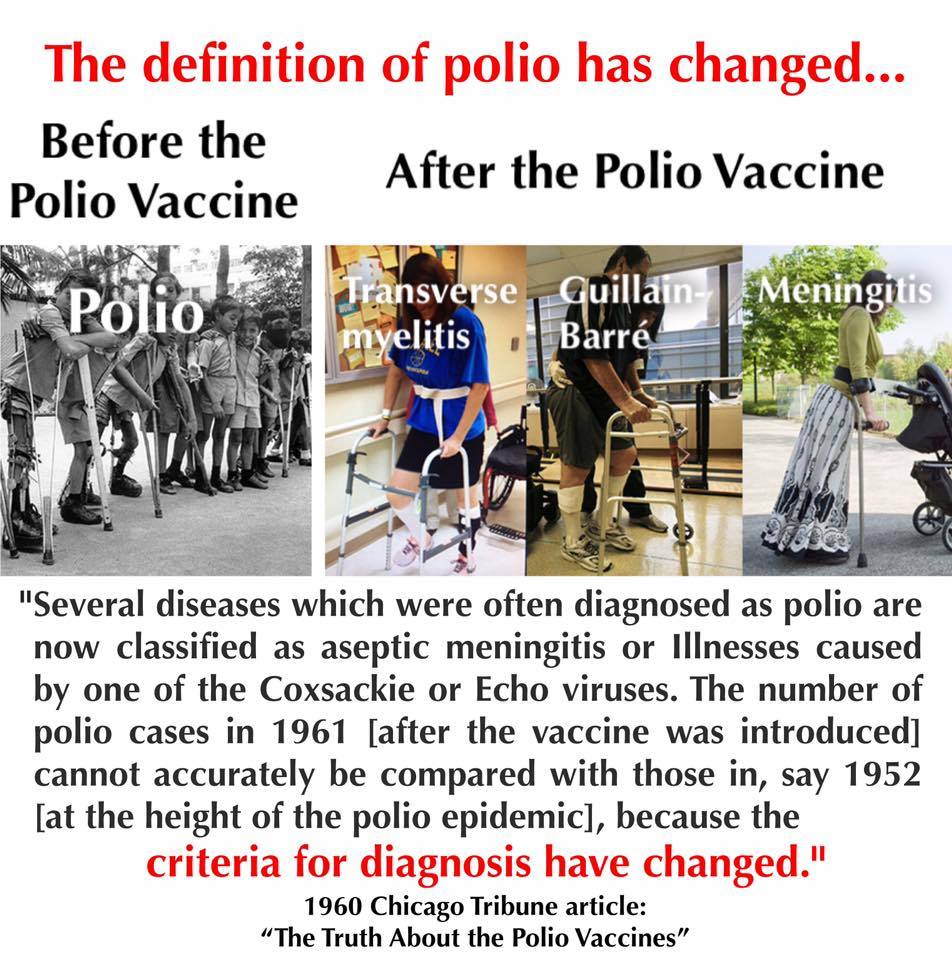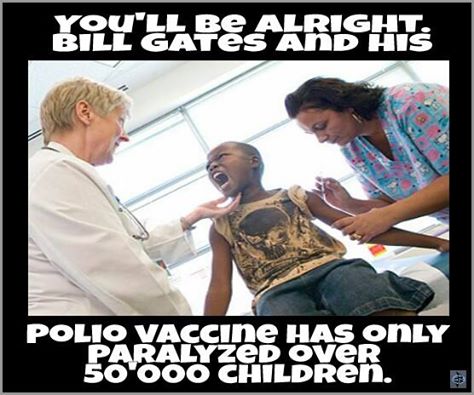
Hiding Polio quotes
Diagnosis Polio
[Polio now hides behind these names: acute flaccid paralysis (AFP), Transverse Myelitis, Viral or aseptic Meningitis, Guillain-Barre syndrome, Chinese Paralytic syndrome, CHRONIC FATIGUE SYNDROME, epidemic cholera, cholera morbus, spinal meningitis, spinal apoplexy, inhibitory palsy, intermittent fever, famine fever, worm fever, bilious remittent fever, ergotism, ME, post-polio syndrome, Synonyms for GBS]
See:
flaccid
paralysis
Chinese Paralytic syndrome
Salvation (Hiding Evil)
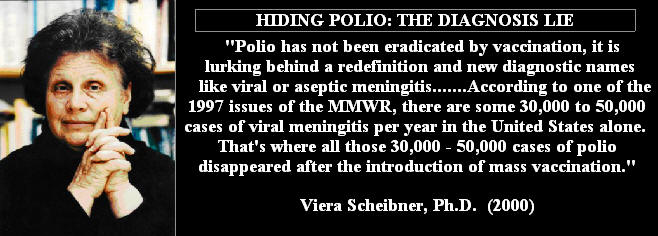
Viera Scheibner, Ph.D.
Testimony, Burton hearings
"They started vaccinating in 1985 (in the Americas). Within 4 months they had 350 cases…They caused a substantial, huge outbreak of polio but they started ‘discarding’ most of the cases (put as flaccid paralysis)."—Viera Scheibner, Ph.D.
[pdf 2012] Polio programme: let us declare victory and move on while India has been polio-free for a year, there has been a huge increase in non-polio acute flaccid paralysis (NPAFP). In 2011, there were an extra 47,500 new cases of NPAFP. Clinically indistinguishable from polio paralysis but twice as deadly, the incidence of NPAFP was directly proportional to doses of oral polio received. Though this data was collected within the polio surveillance system, it was not investigated. The principle of primum-non-nocere was violated.
[2012 April] Rise in paralysis cases after polio vaccine a definite co-relation between the increase in the number AFP and the irrational administration of OPV. Normally, he said, the chances of children under the age of 15 getting affected by non-polio AFP are 1-2 per 100,000. But, the rate of non-polio AFP nationally “is now 12 times higher than expected.” In 2011, an additional 47,500 children were newly paralyzed, over and above the standard rate of 2 children per 100,000 non-polio AFP cases, says the paper in the journal.
[2011 May] Polio
and lemmings by Hilary Butler
Polio has not been
eradicated at all. And will not be eradicated. Polio has been renamed....Why
have Acute Flaccid Paralysis and Polio been put together? Because Acute Flaccid
Paralysis is a catch-all name for what looks like polio, and what you call polio
when the crucial polio viral tests don't show polio VIRUSES at all. ....While
the cases of "polio" have gone down, cases of polio which didn't return a
positive virus test, and which are now called "Acute Flaccid Paralysis" have
skyrocketed. Nice little bit of magicians' sleight of hand... ???! A
parent who saw that WHO website page, wouldn't know that Acute Flaccid Paralysis
was simply polio of old, which covered the same syndromes and symptoms, caused
by a large variety of viruses, as well as various toxins. A parent looking at
the WHO website, would think to themselves, "Acute Flaccid Paralysis must be
some other "valid" disease in it's own right".....All the kids who used to be on
clumsy iron lungs, are now on high tech iron lungs and renamed under the
autoimmune moniker called Transverse Myelitis and no doubt other creative titles
to spread the decoys around
.......All the kids who used to be on clumsy iron lungs, are now on high tech
iron lungs and renamed under the autoimmune moniker called
Transverse Myelitis and no doubt other
creative titles to spread the decoys around. And
here is
your proof. Hidden away in the forward of a book, by a specialist
doctor. Of course, paralysed cases of transverse myelitis on modern iron lungs
isn't something either the media, or WHO will shout from the rooftops. So today,
instead of kids with polio in callipers and iron lungs, we have lots of kids
with autoimmunity, and .... widespread
chronic diseases.
As a faculty neurologist and neuroscientist at the Johns Hopkins Hospital in Baltimore Maryland, I have spent the last decade evaluating and treating patients with autoimmune disorders of the nervous system. I founded and continue to direct the Johns Hopkins Transverse Myelitis (TM) Center, the only center in the world dedicated to developing new therapies foe this paralyzing autoimmune disorder. Increasingly, I see that more and more patients are being felled by this devastating disorder. Infants as young as five months old can get TM and some are left permanently paralyzed and dependent upon a ventilator to breathe. But this is supposed to be a rare disorder, reportedly affecting only one in a million people. Prior to the 1950s, there were a grand total of four cases reported in the medical literature. Currently, my colleagues at the Johns Hopkins Hospital and I hear about or treat hundreds of new cases every year. In the multiple sclerosis clinic, where I also see patients, the number of cases likewise continues to climb.----Douglas Kerr, MD, PhD
[2009 Aug] LITTLE KNOWN FACTS ABOUT POLIOMYELITIS VACCINATIONS by Viera Scheibner These days, when a vaccinee develops poliomyelitis, it may not be called poliomyelitis; instead, it may be called viral or aseptic meningitis, ascending paralysis (Guillain-Barre syndrome), cerebral palsy (over 75 per cent of cases are not diagnosed at birth but after six months) or other such names. According to MMWR (1997; 32[29]:384-385), there are 30,000 to 50,000 cases of aseptic meningitis every year in the United States. Considering that the vast majority (99 per cent) of the reported cases in the pre-vaccine era were non-paralytic and would have corresponded to aseptic or aviral meningitis, then vaccination has actually increased the incidence of poliomyelitis. In the pre-vaccine era, such high numbers only occurred in some epidemics. Now, such numbers occur every year, year by year.
"Polio has not been eradicated by vaccination, it is lurking behind a redefinition and new diagnostic names like viral or aseptic meningitis.......According to one of the 1997 issues of the MMWR, there are some 30,000 to 50,000 cases of viral meningitis per year in the United States alone. That's where all those 30,000 - 50,000 cases of polio disappeared after the introduction of mass vaccination"---Viera Scheibner
"Today, various other forms of the the word "polio" are still
used to describe the effects of poisoning, though usually with regard to paralysis in
animals. A search of Medline ("polio" and "poison") finds about 45
contemporary articles where poisoning causality is attributed to polio. The terminology
found was: "polioencephalomalacia",
"poliomyelomalacia",
"polyradiculoneuritis", "neurological picture similar to that of
poliomyelitis", "polioencephalomyelomalacia", "lumbal
poliomyelomalacia", "cerebrocortical necrosis (polioencephalomalacia)",
"Lead poisoning in grey-headed fruit bats (Pteropus poliocephalus)",
"multifocal-poliomyelomalacia", "spinal poliomalacia", "Polio and
high-sulfate diets", "Atypical porcine enterovirus encephalomyelitis: possible
interraction between enteroviruses and arsenicals", "Polioencephalomalacia and
photosensitization associated with Kochia scoparia consumption in range cattle",
"bovine polioencephalomalacia". ---Jim West, Health and Research Publications,
http://www.geocities.com/harpub/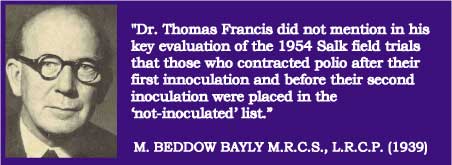
"The United States Public Health Bureau is extremely reticent about reporting diseases caused by vaccination but the report from 1922 to 1931 admitted that there had been 85 cases of post-vaccinal encephalitis, which DeKruif states "is the twin of infantile paralysis.""--Eleanor McBean
In 1958, the CDC formally adopted the “Best available
paralytic poliomyelitis case count” or BAPPCC:
“Cases must be clinically and epidemiologically compatible
with poliomyelitis, must have resulted in paralysis, and must have a residual
neurological deficit 60 days after onset of initial symptoms. .. the BAPPCC does
not include cases of nonparalytic poliomyelitis, of those in which paralysis is
more transient. The original purpose of developing these criteria was to omit
cases possibly due to enteroviruses other than polioviruses.” People who showed
polio like symptoms that previously would have been diagnosed as Polio were now
being diagnosed as: Acute Flaccid Paralysis (AFP), Transverse Myelitis, Viral or
Aseptic Meningitis, Guillaine Barre Syndrome (GBS), Chinese Paralytic Syndrome,
Chronic Fatigue Syndrome, Epidemic Cholera, Cholera Morbus, Spinal Meningitis,
Spinal Apolexy, Inhibitory Palsy, Intermittent Fever, Famine Fever, Worm Fever,
Bilious Remittent Fever, Ergotis, ME, Post-Polio Syndrome aka GBS. Coxsackie
virus and echo viruses can cause paralytic syndromes that are clinically
indistinguishable from paralytic poliomyelitis.
"Paralytic cases were not distinguished from non-paralytic cases until a recommendation was made by the Dominion Council of Health in 1949- The LCDC figures provided from 1952 and onward represent this administrative change: recording only those cases adhering to the requirements for a diagnosis of paralytic poliomyelitis. In a report released in June of 1959, another administrative change was recommended by the Dominion Council of Health, further altering the way in which apparent cases of poliomyelitis would be reported. All non-paralytic cases of poliomyelitis were to be henceforth recorded as "meningitis, viral or aseptic," a disease which itself only became reportable in 1952." These two administrative changes effectively reduced the apparent incidence of poliomyelitis. In particular, since the latter change is temporally correlative to the introduction of the polio vaccines, the vaccines appear to have been responsible for a reduction in poliomyelitis cases when it is entirely possible that the administrative changes are primarily responsible."--Catherine Diodati MA (Immunization History, Ethics, Law and Health p116)
Statistics on polio were manipulated. One such way was to redefine the disease, renaming it "viral or aseptic meningitis" or "cocksackie virus". In one US county, for example, in July 1955 there were 273 cases of polio reported for 50 cases of asceptic meningitis, compared to 5 cases of polio in 1966 and 256 cases of aseptic meningitis. These new diagnostic guideline's were issued by the CDC. If you object to polio vaccination, and you get polio--it is usually called "polio." If you have been vaccinated and you get "polio", it is called meningitis.
Beddow Bayly, author of the book “The Case Against Vaccination” said: “After vaccination was introduced, cases of aseptic meningitis were more often reported as a separate disease from polio, but such cases were counted as polio before the vaccine was introduced. The Ministry of Health admitted that the vaccine status of the individual is a guiding factor in diagnosis. If a person who is vaccinated contracts the disease, the disease is simply recorded under a different name.”Coxsackievirus and echoviruses can cause paralytic syndromes that are clinically indistinguishable from paralytic poliomyelitis. (John H. Menkes, Textbook Of Child Neurology, 5th ed., page 420) http://www3.bcity.com/harpub/
The definition of 'epidemic' was changed from 20 cases/1000,000 to 35 cases/100,000. Pre-vaccination, cocksackie virus and aseptic meningitis were classified as polio; post-vaccination they were classified separately. In addition, non-paralytic polio cases were now reported as viral or aseptic meningitis.
"Ralf R. Scobey, M.D., president of the Poliomyelitis Research Institute. Inc. Syracuse, New York (in the Archives of Pediatrics, Sept. 1950) lists 170 diseases of polio-like symptoms and effects but with different names such as: epidemic cholera, cholera morbus, spinal meningitis, spinal apoplexy, inhibitory palsy, intermittent fever, famine fever, worm fever, bilious remittent fever, ergotism, etc. There are also such common nutritional deficiency diseases as beriberi, scurvy, Asiatic plague, pellagra, prison edema, acidosis etc."--E. McBean
"Dr. Thomas Francis did not mention in his key evaluation of the 1954 Salk field trials that those who contracted polio after their first innoculation and before their second inoculation were placed in the "not-inoculated" list.' (Maurice B. Bayly, The Story Of The Salk Anti-poliomyelitis Vaccine, 1956).Dr. Buchwald responds that prior to the introduction of polio vaccinations in Germany, anyone was counted as having polio, even if they only had the virus in their feces. It is known, he goes on, that there are people who are healthy but who evacuate polio viruses when they go to the bathroom. Based on this criteria, the number of cases was approximately 4,000 per year. After the introduction of the vaccine, statistics included only those polio cases of people who were paralyzed for at least six weeks.--Testimony of Dr Buchwald MD
A former public health officer, Dr Ratner, reported that just before the introduction of the first polio vaccine the National Foundation For Infant Paralysis was paying physicians $25 for each reported diagnosis. "A patient would walk into a doctors office with a limp from an accident. He'd say he had a fever a few days ago...and guess what the diagnosis would be?" It was well known Paralytic polio cured itself 50% of the time within 60 days. After the Salk vaccine was introduced, the definition of polio was changed by the CDC. Now, in order to have paralytic polio, you had to have it longer than 60 days.
Because the Salk vaccine was promoted as being incapable of causing polio, cases that occurred following administration of the vaccine were denied, and excluded from the Vaccine injury table.
Dr. Bernard Greenberg, a biostatistics expert, was chairman of the Committee on
Evaluation and Standards of the American Public Health Association during the 1950s. He
testified at a panel discussion that was used as evidence for the congressional hearings
on polio vaccine in 1962. During these hearings he elaborated on the problems associated
with polio statistics and disputed claims for the vaccine's effectiveness. He attributed
the dramatic decline in polio cases to a change in reporting practices by physicians. Less
cases were identified as polio after the vaccination for very specific reasons.
"Prior to 1954 any physician who reported paralytic
poliomyelitis was doing his patient a service by way of subsidizing the cost of
hospitalization and was being community-minded in reporting a communicable disease. The
criterion of diagnosis at that time in most health departments followed the World Health
Organization definition: "Spinal paralytic poliomyelitis: signs and symptoms of
nonparalytic poliomyelitis with the addition of partial or complete paralysis of one or
more muscle groups, detected on two examinations at least 24 hours apart." Note that
"two examinations at least 24 hours apart" was all that was required. Laboratory
confirmation and presence of residual paralysis was not required.
In 1955 the criteria were changed to conform more closely to the
definition used in the 1954 field trials: residual paralysis was determined 10 to 20 days
after onset of illness and again 50 to 70 days after onset.... This change in definition
meant that in 1955 we started reporting a new disease, namely, paralytic poliomyelitis
with a longer-lasting paralysis. Furthermore, diagnostic procedures have continued to be
refined. Coxsackie virus infections and aseptic meningitis have been distinguished from
paralytic poliomyelitis. Prior to 1954 large numbers of these cases undoubtedly were
mislabeled as paralytic poliomyelitis. Thus, simply by changes in diagnostic criteria, the
number of paralytic cases was predetermined to decrease in 1955-1957, whether or not any
vaccine was used.
Health officials convinced the Chinese to rename the bulk of their polio to Guillaine Barre Syndrome (GBS). A study found that the new disorder (Chinese Paralytic syndrome) and the GBS was really polio . After mass vaccination in 1971, reports of polio went down but GBS increased about 10 fold.......In the WHO polio vaccine eradication in the Americas, there were 930 cases of paralytic disease—all called polio. Five years later, at the end of the campaign, roughly 2000 cases of paralytic disease occurred—but only 6 of them were called polio (41). The rate of paralytic disease doubled, but the disease definition changed so drastically that hardly any of it was called polio any more."—Greg Beattie
"They started vaccinating in 1985 (in the Americas). Within 4 months they had 350 cases…They caused a substantial, huge outbreak of polio but they started ‘discarding’ most of the cases (put as flaccid paralysis)."—Viera Scheibner, Ph.D.
Chronic Fatigue: A polio by another name http://www.sonic.net/melissk/polio1.html
CHRONIC FATIGUE SYNDROME: THE HIDDEN POLIO EPIDEMIC by Dr. William Campbell Douglas
Similarity of polio to pellagra, beriberi, and other deficiency diseases--Eleanor McBean
